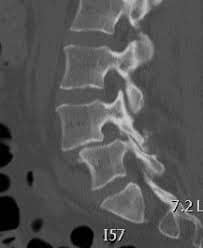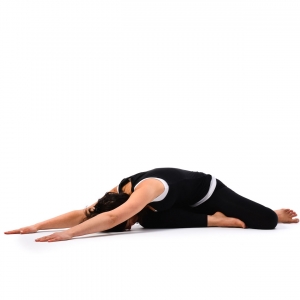Spondylolisthesis
Spondylolisthesis And Physiotherapy Management :
Spondylolisthesis is a spine condition in which one of the bones of the spinal-vertebrae slips out of place onto the vertebra below it. If it slips too much, the bone might press on a nerve, causing pain. Usually, the bones of the lower back are affected.
This word arise from the Greek words spondylos, which means “spine” or “vertebra,” and listhesis, which means “to slip or slide.”

Which symptoms are seen Commonly?
The symptoms vary. People with mild cases may not have any symptoms. However, those with severe cases may be unable to perform daily activities. Some of the most common symptoms are:
persistent lower back pain
stiffness in your back and legs
lower back tenderness
thigh pain
tight hamstring and buttock muscles
Which are the Causes of Spondylolisthesis?
Causes vary based on age, heredity, and lifestyle. Children may suffer from this condition as the result of a birth defect or injury. However, people of all ages are susceptible if the condition runs in the family. Rapid growth during adolescence may also be a contributing factor.
Playing sports may also cause your strain to overstretch and put stress on your lower back. The following sports are especially likely to cause this condition:
football
gymnastics
track and field
weightlifting
Examination:
Physical exams are the first step in diagnosing this condition. Patients have difficulty raising their leg straight outward during simple exercises.

MRI of Spondylolisthesis
X-rays of your lower spine are crucial for determining whether a vertebra is out of place. Your doctor may also look for any possible bone fractures on the X-ray images.

The treatment depends on the severity of pain and vertebra slippage. Nonsurgical treatments can help ease pain and encourage the bone to go back into place. It’s important to avoid contact sports during the healing process.
Types of Spondylolisthesis
Different types of spondylolisthesis may be caused in various ways. Some examples are:
Developmental Spondylolisthesis: This type may exist at birth or may develop during childhood, but generally is not noticed until later in childhood or even in adult life.
Acquired Spondylolisthesis: Acquired listhesis can be caused in one of two ways:
- With all of the daily stresses that are put on a spine, such as carrying heavy items and physical sports, the spine may wear out (ie, degenerate). As the connections between the vertebrae weaken, this may lead to spondylolisthesis.
- A single or repeated force being applied to the spine can cause spondylolisthesis; for example, the impact of falling off a ladder and landing on your feet, or the regular impact to the spine endured by offensive linemen playing football.
Grades of spondylolisthesis:
Spondylolisthesis can be described according to its degree of severity.
One commonly used description is grades, with grade 1 being least advanced, and grade 5 being most advanced.
This is graded by measuring how much of a vertebral body has slipped forward over the body beneath it.
| Grade 1 | 25% of vertebral body has slipped forward |
| Grade 2 | 50% |
| Grade 3 | 75% |
| Grade 4 | 100% |
| Grade 5 | Vertebral body completely fallen off (i.e.,spondyloptosis) |
Medical Treatment :
Medical Treatments are mostly symptomatic with traction and ergonomic advice.
To Relieve Pain: NSAIDS. ( Non-steroidal Anti Inflammatory Drugs)
Rest.
Support: LS Belt.- Lumbo-sacral Belt support spine and stabilize the spine.
Traction: Continuous Traction also reduces radiating pain and tingling numbness.
Wearing a back brace

Physiotherapy Treatment :
Physiotherapy treatments are mostly type, symptom, and increasing and decreasing factor and grade of listhesis.
Primary Goal Of Physiotherapy :
To Relieve Pain: Pain Relieving Modalities Like SWD, IFT, and TENS are useful modalities to relieve pain, swelling, and muscle spasms.
To Relieve Sciatica Pain: Sciatica is associated with symptoms and to relieve sciatica pain, Lumbar traction and IFT is usually preferential Modalities Physiotherapist Mainly used.
Exercises :
Following are a few of the best exercises for treatment:
This Exercise is For Guidance Purpose, It May Vary According To Condition And require physiotherapist guidance before doing it.
1. Pelvic tilt:

Lie on your back with your knees bent and your feet flat against the floor. Pull your belly button toward the spine using your abdominal muscles and focus on pressing the low back flat against the floor. Hold this position for 10 to 15 seconds, and then relax. Do 10 repetitions of this exercise for in sets of three.
2. Dead bug:

This exercise is a more advanced version of the pelvic tilt. You begin this exercise in the same fashion: on the back with the knees bent, feet flat against the floor and arms at your sides. Draw the belly button toward the spine as you tighten the abdomen. Keeping the legs bent, lift one of them off the floor and hold it for five seconds before lowering it to the ground and lifting the other leg for five seconds. Next, lift one arm over the head; hold it for five seconds then lower it. Repeat with the other arm. Once this becomes easy, you can double up, lifting a leg and the opposite arm at the same time. Repeat this sequence for five to ten repetitions in sets of three.
3. Partial curl: Begin this pose the same way as the pelvic tilt exercise. Tuck the chin to the chest and curl the upper body forward to lift the shoulders off the floor with your hands straight out in front of you. Hold this pose for three seconds before relaxing the abs and uncurling the upper back down to the floor. Breathing out can help you lift your shoulders off the floor. Repeat this exercise 10 times for three sets. To make this more difficult, you can clasp the hands behind the head with the elbows pointed out to the sides (like a crunch) as you perform this exercise.
4. Gluteal stretch: Lie on the back with both knees bent. Rest the ankle of one leg against the knee of the other. Grab onto the thigh of the bottom leg and pull it toward the chest until you feel a stretch in the buttocks and possibly the outer part of the hip. Hold this pose for 15 to 30 seconds before switching legs. These stretches should be repeated three times for each leg.
5. Double-knee to chest: This exercise is similar to the dead bug back exercise. Start with the knees bent and feet flat against the floor. Tighten the abdomen to push the low back against the floor and lift both legs off the ground and pull them to the chest. Hold this pose for five seconds then lower the legs back down to the ground. Repeat 10 to 20 times.
6. Quadruped arm/leg raises: For these back exercises, begin on your hands and knees. Tighten the abdominals; while doing so, raise one arm and the opposite leg. Hold this pose for five seconds and then lower the leg and arm to the ground and repeat with the opposite arm and leg. Complete 10 repetitions on each side.
3 Exercises to Avoid :
1. Heavy weightlifting: Weightlifting, especially if you use improper lifting techniques, can take a toll on your back in many ways. While lifting, you’re placing extra strain on your back, specifically on your lower or lumbar region.
2. Twisting or bending: Although core exercises for spondylolisthesis can be vital in strengthening your abdominal muscles and your back, make sure to avoid those that involve excessive twisting to the side or bending over such as toe touches. This may cause further injury to your spine and cause additional pain.
3. High-impact activities: It’s important to remain active during your recovery process, but it’s advised to stray away from those exercises that may cause harm to your back. Exercises such as running, basketball, football, etc. should be avoided until you’re healed.
Care in Spondylolisthesis : ( Back Care )
- Avoid Jerky Back Movement
- Avoid Heavyweight Lifting activity
- Rest in Between Day-to-Day Activity
- Wear Regular LS Belt During Work/Day to Day Activity
- Avoid Sport that creates Extra Back pressure.
- Do Exercise Regularly
- Reduce Weight/Fat loss
- Regular Follow-up Physiotherapist / Doctor.







One Comment